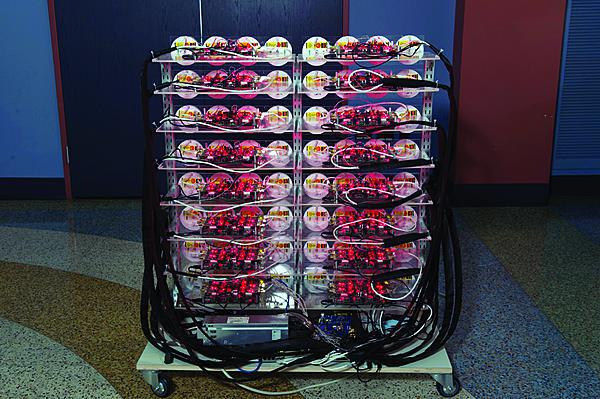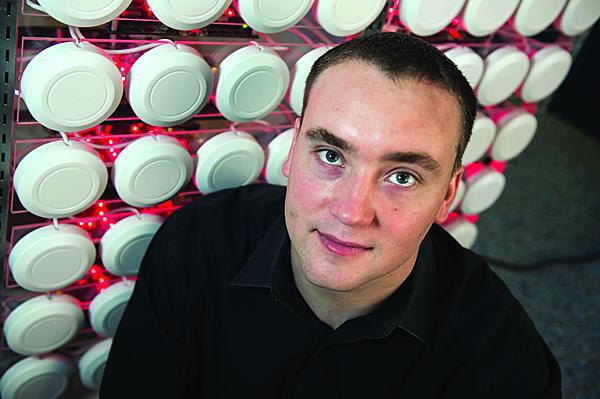Multi-Antenna Research Overcomes Frequency Shortages
Beamforming could help increase capacity of cellphone networks to meet the demands of data-hungry smartphones and tablets.
Multi-antenna technology that could increase data capacity and maximize existing spectrum use for cellular network providers is in the early stages of development. Although widespread use of this technology will require new devices and possible network changes, the concept has shown the potential to ease mobile device congestion from smartphones and tablets. This research is underway at a time when wireless carriers worldwide are scrambling to keep up with demand for mobile data and, in some cases, are attempting to obtain additional electromagnetic spectrum.
Dubbed Argos, after a creature with 100 eyes from Greek mythology, the multiple antenna technology is being developed primarily by the Electrical and Computer Engineering Department at Rice University in Houston, Texas. Researchers at Alcatel-Lucent/Bell Labs and Yale University also are participating in the Argos program.
While Argos is being developed for electromagnetic frequencies used by smartphones and tablets, the underlying technology theoretically could be used for any device that requires an antenna, according to Clayton Shepard, a Rice graduate student who constructed the experimental Argos antenna array, which has been successfully tested. “The frequency really doesn’t matter, and eventually, we would like to make this for Wi-Fi, or any wireless application,” he says. Technology limitations of size and cost are the primary reasons why Argos is being developed for cellular network frequencies, Shepard adds.
The goal of the Argos research is to leverage more antennas in a wireless base station to improve power and capacity of the wireless network. One of the benefits would be an extension of battery life for mobile phones, tablets, laptops or whatever mobile device a user happens to be carrying, he notes. Another would be to increase the bandwidth available for the reception and transmission of data.
The underlying technology, known as multi-user beamforming, has been around for many years. Implementing the concept has been difficult until recently when collective developments in hardware, computing, synchronization techniques, and standards for wireless devices made it viable. The theory calls for the use of multiple omnidirectional antennas to create a very directional antenna, Shepard outlines. Electronics make it possible to move to where that virtual directional antenna is pointing, employing many of the same practices applied in commonly used devices such as radar. “Not only that, but you also can create multiple very-directional beams simultaneously,” he adds. These beams do not interfere with each other, and they deliver much more power to a device than would be possible with only one omnidirectional antenna.
The prototype built and tested by Shepard uses an array of 64 cellular antennas combined by electronics mounted in a pair of mobile racks to create a single wireless base station. The base station delivered an improved signal directly to 15 separate devices via narrowly focused directional beams originating from one array. The focused beams mean that more devices can be provided with more data using more bandwidth and less power than a comparable single omnidirectional antenna module. The results of the test array, if applied to commercial wireless providers today, would translate into a sixfold increase in network capacity over existing antennas. The prototype array, he says, was built for around $300,000, and it includes off-the-shelf hardware and test devices built at Rice’s Center for Multimedia Communication.
Shepard says that results of his tests are compelling. The Argos technology is scalable, and if current research is any indication, wireless providers theoretically could increase the number of devices that one antenna array addresses and achieve an improved signal by a factor of 12.
Some of the current research seeks to refine the Argos beamforming technology to deal with how quickly users with mobile devices, such as smartphones and tablets, move around. “If you had an environment where all these users were just sitting still, and you had tons and tons of antennas, your only limiting factor would be the number of users,” he explains. As soon as they begin moving, the data beam has to be relocated. The action of following that user adds computational overhead to the system, reducing the power and signal efficiency of the Argos antenna array, Shepard says. The faster the users and their devices move, the more tracking is added overhead.
Another benefit that accrues from using the Argos beamforming multi-antenna technique is improved data transmission security. “That’s because you have these very narrow beams, and you’re not scattering the transmission all over the cell, so it’s much harder for someone to snoop or jam the transmission,” Shepard adds.
Argos is at least five years away from being implemented in a practical manner in the commercial wireless industry, Shepard emphasizes. Developing usable devices that could take proper advantage of beamforming would require wholesale change in the technical standards and protocols that govern the operation of wireless mobile devices. Shepard acknowledges that it often takes years for government and industry to agree on such changes. Then, a new generation of smartphones and tablets based on those new standards would be required, and the new devices would have to be adopted by a large number of people to achieve the power and bandwidth efficiencies suggested by the research to date.
Still, Shepard says it is inevitable that the industry will have to adopt and deploy more antennas to deal with the steadily increasing demand for wireless data access. “It’s a question of when; what techniques are used; and how many antennas?” He says new standards already are in place for Wi-Fi that call for the use of as many as four antennas and for digital cellular using as many as eight antennas.
Looking ahead, Shepard says the next step will be building and testing a new Argos antenna array. “We’re going to be testing how this behaves in a multicellular environment and looking at all the factors that affect performance,” he explains. Those factors will include dynamic switching of the individual beams and user paging. Other experiments will address the issues surrounding real-time mobility and the long-term reliability of the Argos technology in a real-world commercial wireless environment.
Argos also will be keeping Shepard personally busy for the next few years. The research is at the center of his doctoral thesis, and he is helping to organize a start-up company that would bring the benefits of Argos to industry. Shepard’s primary research co-author is Lin Zhong, an associate professor of electrical and computer engineering at Rice. Collaborators include Yang Richard Yang from Yale University, and Li Erran Li and Tom Marzetta from Alcatel-Lucent/Bell Labs. Funding for the Argos research project was provided by the National Science Foundation, Alcatel-Lucent and the Air Force Office of Sponsored Research.






Comments